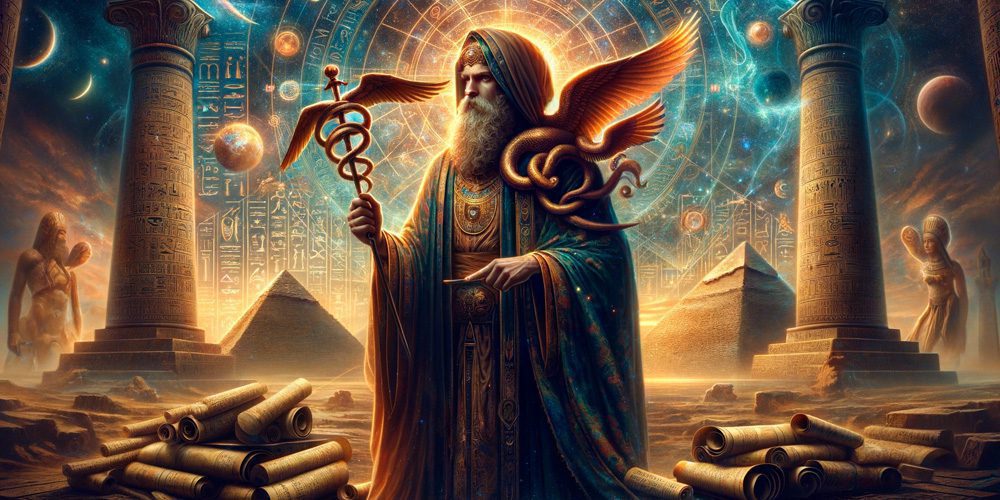In a world where noise and chaos often drown out tranquility, it’s worth taking a step back, an inward retreat of sorts, to explore the profound teachings of Hermeticism. This ancient branch of philosophical and spiritual thought is far from abstruse esoteric mumbo-jumbo.
Rather, it is a timeless wisdom that offers practical insights into the mysteries of existence. Hermeticism floats in the unique space where philosophy, religion, spirituality and science converge.
It isn’t confined by rigid dogmas but rather encourages a relentless pursuit of self-knowledge and universal understanding. It’s about achieving balance—of body, mind, spirit—and realizing our inherent unity with all creation.
The doctrines of Hermeticism are replete with paradoxes that challenge our conditioned perceptions and provoke us into thinking beyond our comfort zones. One such example is: “The universe is mental – held in the mind of The All.” It suggests that everything we perceive as reality originates from thought—quite a mind-bending concept!
At its core, Hermeticism invites seekers to transcend their emotional states by harnessing their mental faculties—a promising proposition for anyone seeking equanimity in this tumultuous world. So what are you waiting for?
Ready to dip your toe into these mystical waters? Let’s journey together down this rabbit hole…
Hermes Trismegistus: The Celestial Scribe
Anchoring us firmly between myth and history lies Hermes Trismegistus (“thrice-greatest Hermes”), believed by some scholars to be an amalgamation of the Greek god Hermes and the Egyptian god Thoth. This illustrious figure is often depicted clutching an emerald tablet inscribed with cryptic symbols and sacred wisdom. The enigmatic Hermes Trismegistus is considered the progenitor of Hermetic teachings and the patron of alchemy, astrology, and other esoteric sciences.
His blend of Greek philosophy and Egyptian mysticism is said to have influenced a wide gamut of sciences, mathematics, religion, and even early forms of psychology. Although historical evidence regarding his existence remains sketchy at best, his philosophies continue to reverberate through millennia.
The Corpus Hermeticum—a collection of dialogues attributed to Hermes—has had a profound influence on Western mystical thought. Interestingly, Hermes isn’t just a figure frozen in time; he has been reinterpreted in various cultures over centuries—sometimes as a god or demigod, sometimes as a wise human sage.
Regardless of how he’s depicted or what name he’s given, his wisdom endures as timeless truths about life and existence. The study of Hermes Trismegistus provides an enriching framework for understanding not just hermetic principles but also the shared philosophical undercurrents across various ancient civilizations.
Decoding Existence: Understanding the Philosophy & Principles
Hermetic teachings are like a cosmic blueprint that guides us in exploring our innate potential while encouraging us to live harmoniously within the larger tapestry that is Life. It offers tools for achieving inner tranquility amidst external turmoil—a vision that many spiritual traditions share. The crux of Hermeticism lies in its seven principles stated in “The Kybalion,” considered by many as a cornerstone text offering succinct yet profound insights into life’s intricate maze.
These principles aren’t prescriptions but descriptions—pointers toward deeper truths behind apparent realities. The first principle—the Principle of Mentalism—posits that all is Mind; the universe is mental.
It’s a bold assertion that reality isn’t just a product of chemical reactions or physical laws, but of thought itself. In essence, it suggests we participate in shaping our realities through our thoughts.
Next comes the Principle of Correspondence—”As above, so below; as within, so without.” It articulates profound interconnectedness among all things and levels of existence. If you understand patterns at one level (say, your subjective experiences), you can potentially unlock understanding at another (say, the cosmos).
The remaining principles—Vibration, Polarity, Rhythm, Cause and Effect, and Gender—each offer unique perspectives on life’s dynamics. As we delve deeper into them in later sections, prepare to be amazed by their depth and universal applicability!
Delving Deeper into Hermetic Principles
Our adventure into the heart of hermeticism is about to get a tad bit more intense, dear reader. Let’s take a plunge into the mighty ocean of Hermetic Principles – they’re not just part of some arbitrary list. They are the commandments that govern the universe, according to Hermes Trismegistus himself!
These seven principles are not just arcane wisdom from an ancient tome, they can be applied here and now in our everyday life. So, ready to unravel these profound secrets?
Buckle up! It’s time to dive deep beyond the surface and explore how these principles could help us see our world and ourselves from an entirely new perspective.
And who knows? You might end up finding more questions than answers.
But fear not! Isn’t that what any journey of discovery is all about?
Treat this section as your personal roadmap through hermetic philosophy – but remember, you’re in charge of your own interpretation. So without further ado, let’s delve right in.
Mentalism – It’s All in Your Mind, Literally!
We begin our cosmic journey with mentalism — it’s all about mind over matter here! You see, according to hermetics everything around us is mental; the Universe itself is Mind. This means that all things visible and invisible originate from thought or mind – meaning your mind holds immense power over your reality.
Of course, it’s a lot deeper than picturing a cheeseburger and having it materialize before you – we’re talking about fundamental shifts in perception and consciousness. The Mental Universe concept might feel a little heady at first glance (pun totally intended), but remember this simply means that everything we perceive is influenced by our mental state.
After all, perception IS reality. So, dare to dream big and bold!
According to hermeticism, what you think and believe shapes the world around you. Before scoffing at this idea, take a moment to consider: have you ever noticed how negative thoughts breed negative outcomes?
Correspondence – As Above, So Below; As Within, So Without
Moving on from mentalism, let’s say hello to correspondence – or as we like to call it: The Principle of Cosmic Symmetry. This principle revolves around the notion that there is always a correspondence or similarity between the laws of phenomena across different planes of being. Basically, all planes (physical, mental or spiritual) interact and correspond with each other.
As within so without; as below so above – this phrase embodies the concept of correspondence beautifully. Everything happening within us is mirrored outside us and vice versa.
It’s like an infinite number of mirrors reflecting each other. The beauty in understanding this principle lies in realizing that change can be enacted from any point whether “above” (the spiritual plane), “below” (the physical plane), from “within” (the interior world) or “without” (our external reality).
Vibration – Feel the Frequency, Folks!
Vibration – it’s not just about your phone notifications anymore! In hermetic philosophy vibration holds a lot more importance than alerting us about a new email – it’s what makes up our very existence.
This principle states that everything is in constant motion; nothing rests and everything vibrates at different frequencies – including you! Yes indeed dear reader: Your body has its own unique vibrational signature. Cool, right?
So what’s the deal with everything buzzing? Well, we can use this principle to our advantage!
By raising our vibration and aligning ourselves to higher frequencies, we can attract positivity and better opportunities. Remember, like attracts like.
So if you set your frequency tuner on ‘Happiness’, you’re more likely to attract joyous experiences. Now that’s some sweet science!
Polarity – Life’s Not Just Black and White
Next up on our magical mystery tour of hermetic principles is polarity – and no, it’s not just about magnets! This principle tells us that everything has an opposite.
At first glance this concept seems pretty straightforward – black has white, cold has hot but wait! There’s a twist. In Hermetic philosophy, these opposites are simply varying degrees of the same thing.
This means that love and hate are actually the same things – they’re both feelings after all! They simply exist at opposite ends of the spectrum.
The real game-changer in understanding polarity is realizing that we have control over where we sit on any given spectrum. That’s right reader – it’s not just about accepting where life drops us; it’s about choosing where we want to be!
Rhythm – Swing with the Cosmic Beat
Rhythm — sounds like something related to music or dance right? Well, in hermetic philosophy rhythm is an entirely different ballgame — but equally intriguing nonetheless! The Principle of Rhythm states that everything flows in and out; there is a rhythm or pattern to everything in existence that influences all aspects of life – from tiny atoms to massive galaxies.
So yes, there is a cosmic beat to all existence – and we are all unconsciously swaying to it. The trick is to recognize this rhythm and learn to dance with it rather than against it.
Once you’re attuned to the universe’s rhythm, you can navigate life’s highs and lows more smoothly. It’s like learning when to push forward or pull back in a cosmic dance!
Cause and Effect – It’s a Domino Effect, Dear Reader
Cause and effect – we’re stepping into familiar territory here! Remember being told every action has a reaction? Well, that’s the principle of cause and effect for you.
But let’s not confuse cause with blame or effect with punishment. This principle simply means there are consequences for every action or thought – not just in the material world but also on spiritual planes.
Lip service aside, really understanding this principle can be life-changing! It means you can take charge of your actions knowing they set off ripples in the universe. So choose wisely dear reader!
Cause and effect is truly about understanding our part in this cosmic play; about recognizing our actions’ potential impact on others as well as ourselves.
Gender – Masculine & Feminine Energies Everywhere
Last but certainly not least on our hermetic list is gender. Now before someone calls out ‘gender politics’, let’s be clear: we’re talking energy here — specifically masculine and feminine energies.
This principle acknowledges masculine (active) and feminine (receptive) forces exist not just in people but everywhere around us from atoms to animals; from stars to galaxies. The idea is that these forces work together to create harmony.
Neither is superior nor inferior – they’re integral parts of the same cosmic machine. By understanding and balancing these energies within us, we can achieve a more harmonious existence – both within ourselves and in interaction with the world around us.
Influences of Hermeticism on Other Philosophies & Sciences
The Cosmic Dance: Alchemy & Astrology – Siblings or Cousins?
As enchanting as it may sound, with hermeticism being the complex and intricate philosophy that it is, its influences have been far-reaching and profound. It’s akin to the ripples created by a stone thrown into a serene pond – subtly disturbing the stillness and spreading outwards in all directions.
Alchemy and astrology are two such disciplines that have felt this ripple. Intriguingly enough, both alchemy and astrology are deeply intertwined with hermeticism, so much so that they can be considered either siblings or cousins.
Both sciences attempt to understand the universe in its entirety, just like hermeticism does. In alchemy, it’s all about transformation – turning base metals into gold, and attaining spiritual enlightenment through physical experiments.
Astrology, on the other hand, deals with celestial bodies, charting their positions and studying their movements for clues about life on Earth. In essence, both are based on the principle of “as above so below”, a cornerstone of hermetic philosophy.
The influence hermeticism had on these two sciences goes beyond mere intellectual curiosity; it’s about understanding our place in this vast cosmos through logic based on observable phenomena. So whether siblings or cousins, there’s no denying that alchemy and astrology were born from the same womb of wisdom as their older sibling: Hermeticism.
Gnosticism – Spiritual Cousins or Distant Relatives?
Gnosticism comes next in this cosmic family reunion we’re having here! Often seen as spiritual cousins to Hermetists (or perhaps distant relatives), Gnostics too seek enlightenment but do so via personal experience rather than tradition. The Gnostics held a belief system where knowledge wasn’t just acquired but experienced firsthand – an approach resonating with hermeticism’s emphasis on direct experience of reality.
Gnostic texts bear a striking resemblance to Hermetic scriptures, suggesting a common source or perhaps mutual influence. The Gnostic practice of introspection and self-analysis echoes the principle of “as within, so without” from the Hermetic philosophy.
It underscores the idea that understanding oneself is key to understanding the universe. Just like how relatives share similar traits owing to their common genetic makeup, Gnosticism and hermeticism share core philosophical ideas – making them more than just spiritual acquaintances.
Renaissance Magic – When Old Meets New
Fast-forwarding in our cosmic timeline, we arrive at the Renaissance period – an era marked by renewed interest in classical learning and wisdom. It was during this time that hermetic principles found their way into Renaissance magic.
Renaissance magic was not about pulling rabbits out of hats but rather about harnessing natural forces for transformation—much like what alchemists aimed for. Magicians in this period saw themselves as intermediaries between heaven and earth, trying to bring about harmony through their practices – a principle quintessentially hermetic.
Famous figures such as Marsilio Ficino and Pico della Mirandola incorporated Hermetic thought into their magical practices, thereby reaffirming its influence during this period. The infusion of ancient wisdom into new practices made it an exciting time for intellectual growth.
Hermeticism’s influence on other philosophies and sciences is thus undeniable – proof of its timelessness and versatility. Its principles permeate various disciplines like subtle threads weaving an intricate cosmic tapestry.
Famous Figures in Hermetic History: Who’s Who in the Cosmic Zoo?
The Mysterious Hermes Trismegistus Himself: The Grandmaster of the Esoteric
When it comes to ancient wisdom, one name takes precedence over others, and that’s Hermes Trismegistus. He is regarded as an embodiment of wisdom, with a fascinating mix of divine and human attributes. Though his existence remains shrouded in mystery, he has left an indelible mark on the philosophical world.
Historians believe that Hermes was not a single individual but rather a representation of a long line of teachers who contributed to hermetic teachings over centuries. His moniker “Trismegistus,” meaning thrice-greatest, underscores his brilliance as he was said to be the greatest philosopher, priest, and king.
Hermes Trismegistus is most famous for penning down the Emerald Tablet- a cornerstone of alchemical thought. It’s here that we find the foundational hermetic principle “As above so below.” This cryptic phrase encapsulates an understanding that what is found in the heavens can be mirrored on Earth and vice versa.
Despite being a figure steeped in mystery, there’s no denying that Hermes Trismegistus’ influence permeates through various philosophies and sciences over millennia. His works have become pillars upon which many spiritual practices were founded.
Whether real or allegorical figure – Hermes Trismegistus’ teachings have endured through the ages – from antiquity to modern spiritual movements. Moreover, his contributions continue to inspire curiosity among seekers of ancient wisdom even today.
Giordano Bruno – Burned but not Forgotten: The Fiery Fate of a Free Thinker
One cannot delve into Hermetic history without mentioning Giordano Bruno- A key figure who paid dearly for spreading hermetic concepts during a time when the Church highly regulated philosophical and religious thought. Born in 1548, Bruno was an Italian Dominican friar, philosopher, mathematician, poet, and cosmologist. His intellect stretched across many disciplines, but his interest in Hermeticism put him on a collision course with the Catholic Church.
Bruno’s audacious stance on heliocentrism (the theory that planets orbit the sun), coupled with his promotion of hermetic doctrines like pantheism (the belief that everything is God) was met with hostility. He was declared a heretic by the Inquisition in Rome.
Despite being given multiple chances to recant his beliefs, Bruno refused to let go of his ideas borne from hermetic philosophy. Consequently, he met an untimely death at the stake in 1600 for his uncompromising stand on intellectual freedom.
In retrospect, Giordano Bruno displayed immense courage standing up for what he believed in despite facing intense persecution. His legacy endures as a symbol of intellectual bravery and freedom of thought amid rigid dogmatism; indeed burned but not forgotten!
Marsilio Ficino – Renaissance Man Extraordinaire: When Stars Align for Wisdom to Shine
The Renaissance era was ripe with brilliant minds that brought fresh perspectives to art and philosophy. Marsilio Ficino stands out amongst these luminaries as an influential figure who helped birth the Renaissance’s Hermetic revival. Born into an established Florentine family in 1433, Ficino’s life took an unexpected turn when he came under the patronage of Cosimo de’ Medici – the great Italian banker who practically ruled Florence during this period.
Ficino had the good fortune of accessing de’ Medici’s vast collection of rare Hermetic texts—most notably Corpus Hermetica—a compilation attributed to Hermes Trismegistus himself! This Hermes-fueled enlightenment pushed Ficino to translate many of these texts from Greek into Latin, making them accessible to a larger audience.
Ficino’s work wasn’t solely academic. He practiced what he learned from the Hermetic teachings.
Ficino believed in the harmony of the soul and the cosmos, leading him to create a form of ‘spiritual medicine’, where music and astrology were used in treating psychological ailments. Marsilio Ficino’s efforts helped elevate Hermeticism into mainstream thought during the Renaissance.
His translations, commentaries, and practices not only enriched his era but continue to impact modern understanding of Hermetic principles. Truly an extraordinary man who bridged ancient wisdom with new-age curiosity!
Hermetic Texts: Ancient Wisdom on Papyrus (and Paper)
The Corpus Hermeticum – The OG of Esoteric Texts
The Corpus Hermeticum, dear reader, is not just any old text. This is the Secret Doctrine of old, the OG of esoteric literature if you will.
These sacred scriptures are a compendium of texts that reveal the secrets and philosophy of Hermeticism in all its glory. Their author?
Well, it’s attributed to Hermes Trismegistus himself – but then again who knows with such ancient manuscripts? This collection was first compiled during the 2nd and 3rd centuries AD and has survived through various translations over the centuries – Greek to Latin, Latin to your friendly neighborhood English.
Within its hallowed pages lies a world where science, astrology, theology and philosophy intertwine in an intricate dance. The texts straddle both the divine mysteries and practical applications of Hermetic laws – think pieces on cosmology alongside pragmatic advice on achieving spiritual ascension.
But it’s not all smooth sailing — some parts are mind-twistingly complex while others come off as surprisingly simple. It’s like a multilayered cosmic onion — peeling back one layer only reveals another waiting underneath.
Still, for those brave enough to delve into its depths, this collection provides an unmatched insight into the core teachings of Hermeticism. So if you fancy yourself a seeker of hidden truths or aspire to be a sage-in-training among mundane men – The Corpus Hermeticum is your guidebook and passport both!
The Emerald Tablet – Short but…
Next up we have The Emerald Tablet – by far one of my favorites! Don’t let its brevity fool you; it might be short but boy does it pack a punch!
Often referenced in alchemical texts and considered a cornerstone of Western Alchemy, this succinct piece is believed to be the concise summary of Hermetic wisdom. Credited to Hermes Trismegistus, it’s a mix of cryptic symbolism and paradoxical statements that keeps scholars on their toes even today.
The most famous extract from the Emerald Tablet is the axiom: “As above, so below; as below, so above.” This encapsulates the principle of Correspondence – there’s a harmonious relationship between microcosm and macrocosm. Such is its fame that you’ve probably seen it on your favorite occult t-shirt or heard it quoted in esoteric discussions!
Yet, to truly understand what The Emerald Tablet says one needs to be versed in symbolism and allegory – like trying to decode a cosmic crossword puzzle. Still, despite (or because of) its brevity and complexity, it’s an invaluable gem in Hermetic literature.
Final Thoughts
We’ve taken quite the journey through ancient wisdom today! From understanding Hermetic principles to diving into texts older than most countries, this article aimed to shed light on a philosophy often shrouded in mystery.
Hermeticism reminds us that learning never ceases – that every question answered often leads us down a path filled with new ones waiting around the corner. So whether you’re drawn by curiosity or seeking enlightenment yourself – remember as long as you keep an open mind and strive for balance; you’ll find what you’re looking for eventually.
After all, as Hermes Trismegistus himself said, “That which is Below corresponds to that which is Above…” So keep questioning below here on earth and who knows? You might just grasp some truths usually reserved for those above!























